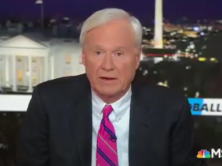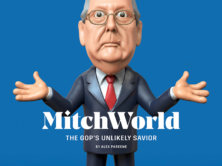
(Credit: Pixabay)
Last Friday, the Washington Post published the results of a poll designed explicitly to see how many people believe false claims made by President Trump. It was the first time the Post had conducted a poll of that type, which the paper labeled a “fact checker” poll.
Mostly it showed that, as the headline trumpeted, “Trump routinely says things that aren’t true. Few Americans believe him.”
But there is more to the poll and some insights the Post may not have conveyed.
The poll included 18 pairs of opposing statements, one of which was true, the other false. Eleven of the questions included false claims by Trump, while four included false claims by Democrats. Two of the questions addressed civic issues (no false claims, per se, by anyone), and one included a true claim by Trump.
The poll did not indicate who had made any of the claims, but simply asked for the respondents’ opinions about the issue itself.
Here are perhaps the five most insightful conclusions from the results:
1.Trump’s major false claims are not believed by most Americans.
Two of the most significant claims by Trump are denial of global warming caused by human activity, and denial of any Russian interference in the 2016 presidential election.
On both accounts, 65% of Americans, according to the poll, disagree with Trump’s position, while only 19% and 15%, respectively, agree.
Americans also deny four other Trump claims:
By 51% to 26% that a wall between Mexico and the United States is already under construction;
By 44% to 25% that millions of fraudulent votes were cast in the 2016 presidential election;
By 41% to 30% that long-standing U.S. laws required separating undocumented immigrant parents from their children; and
By 39% to 15% that Democratic senators have signed onto a bill promoting an “open borders” immigration policy.
2. It’s not clear that the news media influence public opinion.
The authors of the study assert that “Where Americans get their information is a significant factor in determining what they believe.” But their support of this contention is weak.
They show that people who get their news from the Fox network are 12 points on average (33%) more likely to believe Trump’s false claims than people who don’t watch Fox as a main news source (21%).
Similarly, people who watch MSNBC and CNN for their major news sources are 14 points and 12 points, respectively, less likely to believe Trump’s false claims than non-regular viewers of each network.
The problem with these simple cross-tab comparisons is that people tend to watch the networks that reinforce their views. So, it’s quite possible that the differences cited above are caused not by the media organizations, per se, but by people grouping with others in their own media bubble.
It is possible statistically to run regression analyses that will take into account people’s political orientation – political ideology, party affiliation, and who they voted for in the 2016 presidential election – to determine whether the media outlets exert an influence beyond those factors.
But the Washington Post article does not report on such sophisticated statistical analyses. Thus, for the moment, we cannot conclude with the authors that the media significantly influence what people believe.
3. A whole lot of people are unengaged in the issues of the day.
The poll revealed that the average “unsure” response on the 18 items was 34%. That is a whoppingly large percentage compared to the typical poll results, which show on average only about 5% of the public without an opinion on almost any issue (peruse the many polls on The Polling Report for examples.)
On some issues, the unengaged public was even larger:
- Two-thirds of the public had no idea, right or wrong, what U.S. Steel was planning (despite Trump’s many assertions that the company was planning to build six more new plants in the country).
- Half the public had no inkling as to whether the recent tax cut was the largest in U.S. history.
- Close to half (44%) didn’t opine on whether Democratic senators had signed onto a bill promoting an “open borders” policy.
- Four in ten (39%) felt they couldn’t say what percent of guns are sold without background checks.
If you’re thinking that these are rather arcane issues and we shouldn’t expect the average citizen to be super attentive to all issues – I agree. But it’s worthwhile noting now and then that polls, including those by the Washington Post, typically present the fiction that more than 9 in 10 Americans have a meaningful opinion on virtually any subject.
This poll phrased its questions a bit differently from most polls. In addition to asking which of the two items in each pairing was correct, the instructions explicitly said: “If you don’t know the answer, just select ‘unsure’ rather than guessing.” By giving respondents permission to admit ignorance, many more people did so (and chose “unsure”) than would have in a typical poll, which doesn’t include such permission.
The large segment of the public that is not engaged in public policy is further demonstrated in one of the poll’s question on how closely people follow the news about politics and government. Just 24% said “very closely,” while 29% said “not much” or “not at all.” A plurality of Americans (47%) is in the murky middle, watching the news “somewhat closely.”
We should remember the large unengaged part of the public the next time there is a poll showing 95% of Americans with a meaningful opinion. We shouldn’t believe it.
4. There is a false equivalency factor to this poll.
It seems evident the authors were motivated to conduct the poll because of the incredibly large number of false claims by President Trump that have been documented by the Post. And, to be fair, the authors make that patently clear in their report. The headline (noted above), along with a couple of paragraphs in the report itself, explain why the poll was conducted.
“The poll sought to determine what Americans believe — the truth or the president. The Post has never conducted this type of poll before and it serves as the most comprehensive examination of whether Trump’s false and misleading claims have taken root among the broader American public.”
Later in the report, the authors note:
“Since becoming president, Trump has made 6,420 false or misleading statements through Oct. 30, including more than 4,400 this year, according to a database maintained by the Fact Checker.
“Unlike many politicians who will abandon an untrue claim when fact-checked, Trump generally repeats his falsehoods. To capture this phenomenon, the Fact Checker this week introduced the Bottomless Pinocchio, a new category awarded to politicians who repeat a false claim so many times that they are, in effect, engaging in campaigns of disinformation. Fourteen of the president’s statements qualify for the list.”
Fair enough. This president is different from any other major American politician, Republican, Democrat, or independent.
But then why scrounge around for some kind of equivalency with Democrats? The authors came up with four false claims by Democrats – by Hillary Clinton during the 2016 campaign, by Bernie Sanders in February 2018, by Elizabeth Warren in June 2018, and by Alexandria Ocasio-Cortez, during her campaign in July 2018.
The Post said that Sanders’ false claim was based on old data, that Clinton “flubbed” her analysis of the Bush tax cuts, that Warren had apologized for her error and clarified (accurately) what she meant to say, and that Ocasio-Cortez made “bloopers” that “the average member of Congress might make.”
It’s excruciatingly obvious that none of the Democratic false claims cited in the report is comparable to the “Bottomless Pinocchio” claims by Trump that are also included in the poll.
It would have been easy for the Post to find numerous individual Republican politicians who have made the kind of false claims that the Post found for the Democrats. In fact, the Post explicitly acknowledged that in Warren’s case, her false claim was “bipartisan,” and that the paper had called out Republicans for the same item.
Yet, the Post seemingly felt obligated to throw in some Democratic false claims as a kind of balance to the many false claims made by Trump – just to show they are not partisan. And that’s understandable in most cases. But sometimes, there is no one-to-one comparison that makes sense.
The Post acknowledges this point when it notes that no other politician has qualified for a “Bottomless Pinocchio” besides Trump, who has 14 to his credit. He is in a class by himself.
So, let’s drop the false equivalency.
5. The poll probably underestimates the number of people who support Trump’s positions
The authors deliberately refrained from informing respondents which position (in each question pairing) Trump had espoused. They did so in the belief (supported by research) that respondents can be influenced by what they believe other prominent people think.
If this poll was intended to measure the influence of Trump’s false claims, a different strategy would have been to make it clear what Trump’s position was on each issue and then ask respondents if they agreed or disagreed. Of course, such an approach could have influenced anti-Trump respondents, as well as pro-Trump respondents.
That approach, however, is probably more akin to reality than the antiseptic environment of a poll interview, in which many people are giving opinions off the top of their heads with little to no context.
In the “real world,” most people probably learn about issues in the context of who is supporting and opposing them. Removing that bit of knowledge in the poll project can produce a rather distorted picture of public opinion – one that is relatively divorced from the context in which public opinion is actually formed.
It may be true that most people disagree with some of Trump’s false claims, but once informed of his views, they might well change their minds. This poll misses that dynamic.





